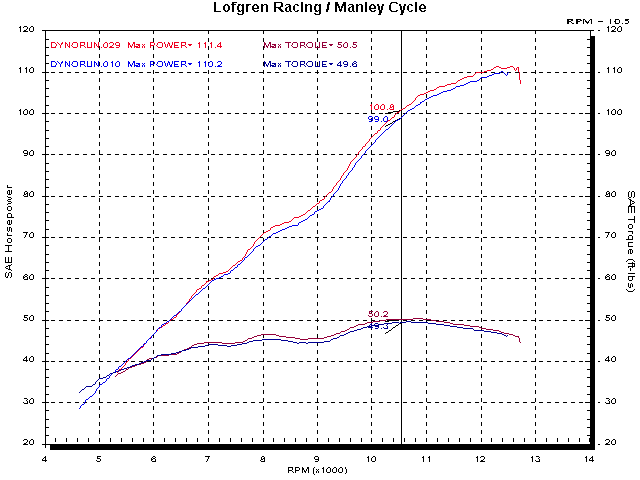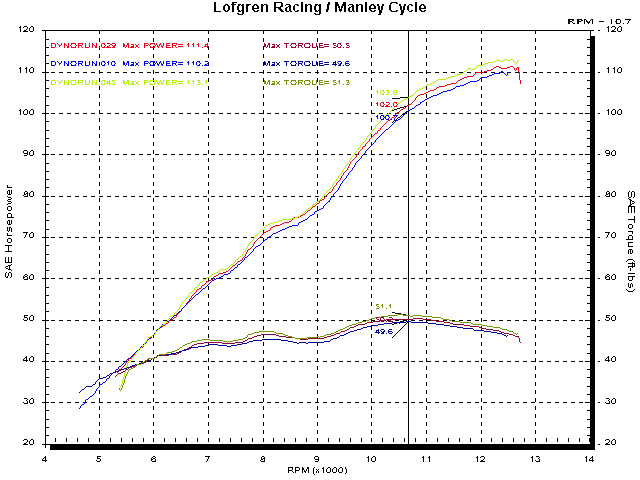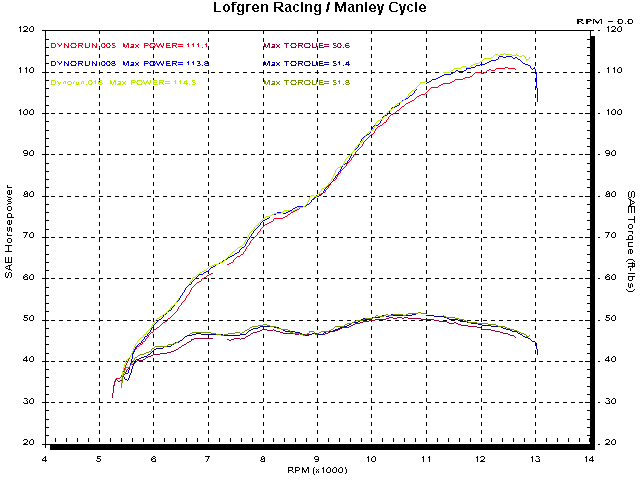
Re-mapping a couple MV F4s
Both of the bikes used in this report are model year 2000. They are rated at 126HP at 12200 RPM. Most likely, this is measured at the gearbox output sprocket.
One thing that I noticed in the specifications for these bikes is that the torque is rated at 9000 RPM. Take a look at any of the charts below and you will notice that 9000 RPM is neither 'the' torque peak, nor 'a' torque peak. Either the ratings come from somewhere much earlier in the development cycle, with a completely different exhaust system, or there is a 'killer' air-box resonance.
I had the opportunity to ride Brent Van Tassel's MV late last summer, but it was only in town and, not surprisingly, it wasn't a very interesting ride.
At that time I also read the chip and saved the file. When I tried to look at the maps, it became clear that the maps on the MV chip had different addresses than those on the Ducati or Laverda, or Guzzi chips.
Over the last 7 years that I've had the FIM software I've recieved a lot of information from Duane Mitchell and done enough mucking about at the chip file level that I've learned a bit about how to recognize maps. With the investment of some time I created a configuration file to recognize the MV chip. I had to find the RPM and throttle set-points for both the fuel and the ignition maps as well as the maps themselves. I also found the RPM limit addresses.
Once I could view the maps, I was less sure that I had the correct addresses. The maps weren't as smooth or consistent as the ones I'm used to seeing. I just had to wait until I could make some changes and confirm that the effects occurred at the points I intended, or not.
There's one other change I made to the map. One of the RPM set-points on the map was 9500. As you can see on the chart below, there is a pipe tuning dip at 9000 RPM. I decided to change the 9500 RPM set-point to 9000 RPM so I could tune for that dip.
The first one I attacked was Brent's.
While warming it up on the dyno, with the chip that it came with, it felt as if the throttle response was pretty 'soggy', especially at real low RPM. That won't be indicated by any of the dyno charts, it's definitely subjective
The first charts shows the results of getting the air/fuel ratio better all thru the WOT line of the map. The red trace is the new and improved A/F ratio.

At some point, staring at the computer screen (black and white, DOS mode) I noticed that the ignition timing numbers were quite high. In the 50 degree range. It dawned on me that I might try retarding the WOT ignition timing. Well, I did and it liked it. The final ignition timing effects are shown below. The green trace is added to the same runs as on the previous chart.

The next one belongs to Michael Shea. I baselined it with the chip that was in it. That was the same one that was in Brents.
The red trace on the chart below is the baseline, the blue one is with the same chip as Brent's, and the green is after some WOT fuel changes.
I've done an article about the variations between bikes. You might find it interesting; Air/fuel Ratio Variations in the Ducati 996
I'm still not sure how many variables there are and if they are significant, but the same holds true in this case.
In the case of Michael's you can see the improvements below and above the 9000 RPM dip, and there was quite a bit of variation at all of the part throttle stuff.

I've seen the troubles that Duane (Mr. FIM, now Ultimap Plc) (http://www.fuelinmoto.com.au/) and Bruce Meyers (BCM) (http://www.bcmducati.com) have had supporting the chip for the Ducati 996, and I'm reluctant to tell anyone that I can make their bike run right over the phone or the internet.
The most critical aspect of getting a chip to work, is the basic mechanical/electrical set-up of the system. If that isn't at the same starting point as the map, the chances of the chip working properly go way down.
Brent's bike idled at 900RPM and had all of the idle bypass screws shut. The TPS was set at 1.2 degrees at idle, according to the Ultimap software (a great tool for Weber-Marelli equipped systems.) I checked the synchronization and they only needed a slight adjustment with a little bypass on one of each pair of throttle bodies. I added some ignition timing at idle and the RPM picked up to a more stable level, just over 1000RPM.
Michael's TPS was set at 1.6 degrees and his idled at 1250RPM. The idle air/fuel ratio was fine, so I left it alone. (Any of you who've adjusted your idle speed know what a pain-in-the-ass it is.)
I'm sending a couple iterations of the last mapping to Chuck at Eastern Cycle and we'll see if the bike responds positively.